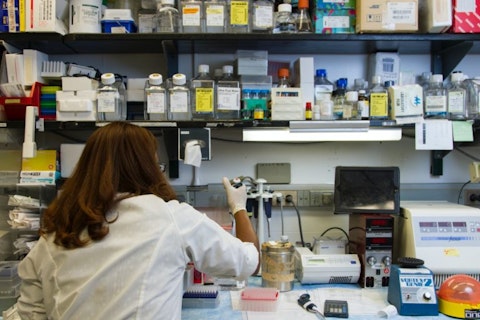Compugen Ltd. (NASDAQ:CGEN) Q4 2022 Earnings Call Transcript February 27, 2023
Operator: Ladies and gentlemen, thank you for joining us today. Welcome to Compugen’s Fourth Quarter and Full Year 2022 Results Conference Call. At this time, all participants are in a listen-only mode. An audio webcast of this call is available in the Investors section of Compugen’s website, www.cgen.com. As a reminder, today’s call is being recorded. I would now like to introduce Yvonne Naughton, Head of Investor Relations and Corporate Communications. Yvonne. Please go ahead.
Yvonne Naughton: Thank you, Operator, and thank you all for joining us on the call today. Joining me from Compugen for the prepared remarks are Dr. Anat Cohen-Dayag, President and Chief Executive Officer; and Alberto Sessa, Chief Financial Officer. Dr. Henry Adewoye, Chief Medical Officer; and Dr. Eran Ophir, Senior Vice President Research and Drug Discovery will join us for the Q&A. Before we begin, we would like to remind you that during this call, the company may make projections or forward-looking statements regarding future events, business outlook, development efforts and their potential outcome, the company’s discovery platform, anticipated progress and plans, results and timelines for its programs, financial and accounting related matters, as well as statements regarding the company’s future cash position.
We wish to caution you that such statements reflect only the company’s current beliefs, expectations and assumptions, but actual results, performance or achievements of the company may differ materially. These statements are subject to known and unknown risks and uncertainties and we refer you to the SEC filings for more details on these risks, including the company’s most recent annual report on Form 20-F, filed with the SEC on February 28, 2022. The company undertakes no obligation to update projections and forward-looking statements in the future. And now, I’ll turn the call over to Anat.
Anat Cohen-Dayag: Thank you, Yvonne. Good morning and good afternoon, everyone, and welcome to our fourth quarter and full year 2022 update. Immunotherapy has been a revolution for the treatment of many patients with cancer. 2022 annual sales of PD-1 pathway inhibitors alone were greater than $35 billion. But still, as we all know, there remains an urgent unmet medical need for the majority of the cancer patients who are resistant to anti-PD-1. To address the needs of these patients, many drug combinations are being evaluated including IO/IO combination. Compugen is the leader in the triple IO/IO combination blocking PVRIG PD and PD-1. While TIGIT blocking antibody in combination with PD-1 inhibitor may function in PDL1 high expressing patients, our data consistently show that the addition of an anti-PVRIG may sensitize tumors to respond to PD-1 and TIGIT blockade even in PDL1 low expressing patients.
As leader in the DNAM axis space, we believe that evaluating the triple combination of our potential first-in-class anti-PVRIG COM701 with our potential best-in-class anti-TIGIT COM902 and the PD-1 inhibitor has the potential to maximize clinical benefit for patients. On this front, we have made significant progress. And I would like to share our top highlights for 2022, which we believe set us up for success in realizing our vision to transform the lives of patients by extending the reach of cancer immunotherapy to those who are resistant to anti PD-1 therapies. First in 2022, we took a strategic decision to narrow down our broad significant study to focus on two indications with high unmet medical needs and less competitive landscape, microsatellite-stable colorectal cancer and platinum resistant ovarian cancer.
We believe that this focus provides us with a high probability of success for several reasons. One, these are indications where we have shown encouraging clinical benefit supported by immune activation that aligns with the COM701 mechanism of action set with the biological rationale and which we believe provides a fastest route to additional meaningful data to info on the next steps in building a path to registration. Two, as a result of our decision to prioritize two indications, we concluded our collaboration with Bristol Myers Squibb, thereby, enabling us to focus our time and cash on two indications, as well as switch to evaluate our own potential best-in-class anti-TIGIT COM902¸ as part of our triple combination going forward. And now that COM701 is no longer restricted, we also have the opportunity to advance and partner both our potential first-in-class anti- PVRIG COM701 in addition to COM902.
And lastly, the decision has made us act to extend our cash runway through at least the end of 2024, which is sufficient time to complete our small proof-of-concept study aimed at strengthening the evidence and derisk our lead assets in these two indications. Moving now to the second highlights of 2022, which was the encouraging clinical data we presented in the fourth quarter of 2022 in two indications. The first set of data we presented was in patients with microsatellite stable colorectal cancer at Citi Conference in November 2022. And the second set of data was in patients with platinum resistant ovarian cancer, which we represented at ESMO Immuno-Oncology Conference in December 2022. As far as we are aware, we are the only company reporting clinical benefit with an immune checkpoint inhibitor supported by an underlying biological rationale in this patient population with microsatellite stable colorectal cancer and liver metastasis, which makes up approximately 70% of the MSS-CRC patients in this metastatic setting.
This is encouraging as this is an indication with a high unmet medical need and these patients has no approved treatment options after failure of standard-of-care therapy. In these patients with platinum-resistant ovarian cancer, there was a lot of excitement from investigators reporting durable shrinking or stabilization of tumor in some of their patients who had previously progressed on all available treatment options. The totality of the clinical benefit in these patients including a 20% of our response rate with several patients responding over 9-months with responses also achieved in a hard to treat high grade serious adenocarcinoma patients, as long with a favorable safety profile is encouraging compared to current standard-of-care. The translational work which centers taken from these patient is inappropriate.
And we expect to share this data in one of the upcoming medical conferences during 2023. In both indications, the clinical benefit is supported by biological rationale and point to a COM701 mediated mechanism of action increasing number, and mediated anti-tumor immunity in tumor types and in patient populations that could not be addressed otherwise. And the third highlight is AstraZeneca rapid progress and continued expansion of their PD-1 TIGIT bispecific rilvegostomig which is derived from our COM902. This progress and continued investment by global leader in oncology, in our opinion, exemplified belief in the TIGIT mechanism of action and more specifically if our differentiated anti-TIGIT, COM902. Like COM902, which is a high affinity reduced Fc effector function anti-TIGIT antibody rilvegostomig was engineered to reduced Fc effector functionality with the potential to enhance antitumor activity.
With Halevy Gilead randomized Phase 2 data with anti-TIGIT antibody and AstraZeneca’s antibody designed strategy, we believe our choice to serve reduced Fc effector function anti-TIGIT is well reinforced. Last year, AstraZeneca for breast rilvegostomig into Phase 2 development in metastatic non-small cell lung cancer and since then AstraZeneca has expanded development for the treatment of non-small cell lung cancer and gastric cancer patients. AstraZeneca announced that it also plans to initiate a Phase 3 study this year and had suggested that this could be one of the 10 programs with a blockbuster potential. It’s great news for us as we may be entitled to receive up to an aggregate of $200 million in milestones for these products as well as royalties on future product sales.
We look forward to the success of rilvegostomig. During our call today, I will provide an overview of the opportunity and path forward in our prioritized indication microsatellite stable colorectal cancer and platinum resistant ovarian cancer. I will go on to describe our next guideline asset, COM503 which is the lead asset in our early pipeline and why we’re excited about this potential. Alberto will take you through the financials. I will summarize our upcoming milestones and then we will open the call up for questions. Starting with the opportunity and fast forward with our prioritized indication, we’re initiating two proof-of-concept studies in platinum resistant ovarian cancer and in microsatellite stable colorectal cancer. The goal of these proof-of-concept studies is to strengthen the evidence, help us better understand the contribution of components, and build on the extensive biomarker work we’re doing to try and understand the patients most likely to respond, with the purpose of building a path to registration in this indication.
Colorectal cancer is the third most common cancer in the U.S. It is estimated that in 2023, approximately 153,000 new cases will be diagnosed in the U.S. and about 52,000 patients will die from this cancer in the U.S. Microsatellite stable colorectal cancer represents about 95% of the colorectal cancer patients with limited treatment options. Around 70% of the patients with metastatic colorectal cancer have metastases to the liver and as far as we’re aware, we’re the only company who has reported clinical benefit in this patient population with a checkpoint inhibitor. I am delighted to report that we have multiple sites open, which are actively screening patients to enroll in our MSS-CRC treatment combination proof-of-concept study. Patients will be eligible if they are PD-1 naive and have received up to three prior lines of therapy, and we will be including patients with liver metastases.
With enthusiasm of our study investigators and the lack of good treatment options for these patients, we anticipate completing enrollment of up to 20 patients and plan to share initial findings this year with full data disclosure expected in the first half of 2024. In terms of what success looks like, we believe that even if we repeat the 12% of our response rate in patients with liver metastases, and also take into consideration other clinically relevant endpoints, such as progression free survival, durability of antitumor activity, death of response, safety, presence of coexisting adverse prognostic features such as KRAS mutation, we would be informed our next step for a potential path to registration ideally with the right partner. Moving to platinum resistant ovarian cancer where there is also an urgent unmet medical need as the patient has very limited treatment option.
Platinum resistant ovarian cancer is a hard-to-treat tumor type with limited T-cell infiltration, which are required for immune checkpoint inhibitors to be effective. Historically, most immune checkpoint inhibitors have demonstrated limited activity in such tumor. It is estimated that in 2023 in the U.S. alone, approximately 20,000 new cases will be diagnosed and 13,000 patients will die of this cancer. We believe that PVRIG’s unique biology, different than other checkpoints have the potential to generate different outcomes in these patients. I’m delighted to say that we’re on track to dose the first platinum-resistant ovarian cancer patient in our triple combination proof-of-concept study in the second quarter of this year. Immune checkpoint inhibitor naive patient will be eligible if they have received up to three prior lines of therapy and we will include patients of all histology.
We plan to employ a phased approach. We will enroll up to 40 patients in total in the treatment with the first 20 patients until the end of the year and the full cohort in the first half of 2024. Once we complete enrollment of the first 20 patients on triplet, we intend to evaluate the inclusion of an additional doublet arm of up to 20 patients, which is a combination of COM701 and pembrolizumab without COM902 to help us better understand the contribution of the components. We’re glad to report initial findings by the end of this year. Together with the data we have in hand, this triplet study is expected to bring us to an overall assessment of up to 50 platinum-resistant ovarian cancer patients on triplet treatment, which we expect will inform us our next step in building a potential path to registration, which again ideally would be done with the right part.
In terms of what success looks like, we believe that if we see at least 20% overall response rate in these additional patients, along with the safety profile reported to-date and taking into consideration tumor histology, and other clinical relevance endpoints like durability of anti-tumor activity, lack of response and progression free survival we would be informed on the next path towards a potential path to registration. Of course in both indication, the identification of the biomarker would greatly contribute to further defining a study population to most likely derive clinical benefit. While identifying biomarker in the field of checkpoint inhibition is not given with our years of expertise in understanding the underlying biology of the DNAM axis, evident by the quality of the translational data we have generated from patient biopsies using cutting edge technology and our computational capability, we believe we are well suited to identify biomarkers which can help define the patients who may benefit from our COM701 combination and will therefore allow us to better design and execute targeted, well defined, randomized studies.
Moving next to our leading early pipeline asset COM503. We’re very excited about the progress we have made with our early stage program originating from our computational discovery engine. While PVRIG and TIGIT were totally new targets and pathways, upon discovery. Our next program is different. Here, we’re targeting a known pathway in a completely unique way with a potential first-in-class PVRIG candidate. We identified a potential dominant immunosuppression mechanism, which is used by macrophages in tumor, to escape the immune system. This is the interleukin-18 binding protein an interleukin-18 complex. The inflammatory induced growing inflammatory cytokine are interleukin-18, is present at high level in the tumor microenvironment, where it is expected to naturally activate antitumor effective cells such as T and NK cells.
But IL-18 is one of the rare cytokines that is naturally blocked by an endogenous, high affinity inhibitor called interleukin-18 binding protein. Cytokine our powerful tools and they are used therapeutically. However, there is a challenge of treating them clinically at levels high enough to reach and modulate the tumor microenvironment without systemic. As a result of their narrow therapeutic window, conventional recombinant cytokines are limited in terms of efficacy. Some recent clinical failures these challenge, specifically IL-18 has been unmetered to cancer patient in the past, but failed most probably because of general limitations of recombinant cytokines just mentioned and potentially because IL-18 is inactivated by its natural blocker IL-18 binding protein.
We bear in mind, we have developed a potential first-in-class truly human high affinity monoclonal antibody COM503 which target IL-18 binding protein to release endogenous naturally occurring IL-18 to activate T and NK cells in the tumor microenvironment. In our preclinical models, we have shown that blocking IL-18 binding protein can display IL-18 from IL-18 binding protein in the tumor microenvironment, enabling the physiological IL-18 to have immune stimulating activity in turn, maybe potent antitumor activity. We believe that one major advantage of using an IL-18 binding protein antibody over administration of IL-18 cytokine is a better therapeutic window due to IL-18 pathway of regulation confined to the tumor microenvironment. We have shown that an antibody against IL-18 binding protein modulates the tumor microenvironment for potent antitumor immunity without affecting peripheral immunity.
We believe that our COM503 program represents a new and differentiated approach to harness cytokine biology for cancer therapeutics. The program is now advancing in IND enabling studies with a goal to file IND in 2024. We plan to present this new approach at a scientific conference in 2023. With that, I’ll turn the call over to Alberto.

Photo by National Cancer Institute on Unsplash
Alberto Sessa: Thank you, Anat. I’m happy to summarize our financial results. I will start with our cash balance. As of December 31, 2022, we had approximately $83.7 million in cash compared with approximately $117.8 million as of December 31, 2021 affirming our focus on capital efficiency and bold execution on our DNAM-1 axis hypothesis. During 2022, we used $41.6 million to fund our operations. And we received in the fourth quarter a $7.5 million payment, by initiation of AstraZeneca Phase 2 study evaluating that PD-1 TIGIT bispecific derived from our COM902. The company had no debt. Going into 2023, we expect our cash burn to be in the range of between $37 million to $39 million. We understand the importance of our cash balance, and we are financially disciplined.
We are constantly monitoring our expenses but at the same time, we are targeting our extensive and unique knowledge in this space on specific tumor types and clinical strategy to increase the probability of success of our drugs to patients. Based on our current plans, we expect that our current cash will be sufficient to fund our operating plan at least through the end of 2024. On the revenue front as just mentioned, we reported $7.5 million revenue from the fourth quarter and for the year ended December 31, 2022 compared with no revenue and $6 million of revenues respectively for each of the comparable period of 2021. Our revenue in 2022 are related to the milestone payments received from AstraZeneca. Now regarding the expense front. R&D expenses for the fourth quarter of 2022 and for the year ended December 31, 2022, were $7.3 million and $30.6 million respectively, compared with $5.8 million and $28.7 million for the comparable period in 2021.
The increase is mainly due to higher expenses associated with our CMC activities offset by higher BMS participation in R&D expenses. Research and development expenses as a percentage of total operating expenses were 73% in 2022 compared to 71% in 2021. Our G&A expenses for the fourth quarter of 2022 and for the year ended December 31, 2022, were $2.5 million and $10.3 million, respectively, compared with approximately $2.7 million and approximately $10.9 million for the comparable period in 2021. For the fourth quarter of 2022, we reported a net loss of $3.1 million or $0.04 per basic and diluted share compared to a net loss of $8.6 million or $0.10 per basic and diluted share in the comparable period of 2021. Net loss for the year ended December 31, 2022, was $33.7 million or $0.39 per basic and diluted share compared with a net loss of $34.2 million or $0.41 per basic and diluted share in the comparable period of 2021.
I’m moving now to the 2023 outlook. Going into 2023, we expect our cash burn to be in the range of $37 million to $39 million. In 2023, we are planning to have a similar level of R&D expenses compared to 2022, mainly to support our upcoming MSS CRC and platinum-resistant ovarian cancer proof-of-concept studies, as well as our leading early pipeline assets COM503. We understand the importance of our cash reserves, and we believe we have sufficient cash to execute on our plan and guidance. With that, I will hand back to Anat to summarize what you should expect from Compugen in 2023.
Anat Cohen-Dayag: Thanks, Alberto. So to summarize upcoming milestones. In MSS CRC, we’re on track to dose the first patient with our triple combination study to complete enrollment of up to 20 patients and report initial findings this year. In platinum resistant ovarian cancer, we are on track to dose the first patient with our triple combination in the second quarter of this year. We plan to complete enrollment of 20 patients and report initial finding this year and plan to complete the full enrollment in the first half of 2024. Taking a staged approach, once the enrollment of the first 20 patients in the triple is completed, we intend to evaluate the inclusion of an additional arm of COM701 and pembrolizumab in the absence of COM902 to gain more insight on contribution of components.
We also continue to monitor the patients in the cohort expansion studies with Bristol Myers Squibb and expect to report findings from these studies, including longer follow-up and translational data from the platinum resistant ovarian forward expansion study in 2023. We plan to present on COM503 during the medical conference in 2023 and to file an IND for COM503 in 2024. Finally, this is a big year for TIGIT results, and we expect to see reach through to Compugen. To this end, I want to emphasize why we believe we have an edge with our differentiated clinical strategy. Firstly, we have a combination approach with a leading anti-PVRIG COM701 against a novel target, which our data suggests may sensitize tumors to respond to PD-1 and possibly TIGIT blockade.
And we’re being followed by others. PVRIG is gaining traction as a relevant testing in our immunology targets with more and more competitors joining these rates, including GSK, while following our triple combination approach. Secondly, we have a differentiated Fc-reduced effector function, high affinity anti-TIGIT COM902 which we believe was reinforced recently. And finally, we’re targeting tumor types typically not responding to immunotherapy, where we believe that PVRIG unique biology different than other checkpoints may be exemplified and has the potential to generate better outcomes in these patients, and we would share initial findings from our proof-of-concept study by the end of the year. With that, I will turn the call over to question.
Operator?
See also 17 Most Valuable South African Companies and 16 Best Countries in Basketball.
Q&A Session
Follow Compugen Ltd (NASDAQ:CGEN)
Follow Compugen Ltd (NASDAQ:CGEN)
Operator: The first question is from Stephen Willey of Stifel. Please go ahead.
Stephen Willey: Yes, good morning. Thanks for taking the questions. I guess with the decision to add a doublet cohort to platinum-resistant ovarian cancer, will there be any attempt to try to enroll patients into that cohort that, I guess, are typically similar to the triplet cohort. And I’m just talking about perhaps an effort to try to match baseline characteristics with respect to things like histology, PDL1 expression so that you can get a better kind of apples-to-apples comparison of what triplet is buying you above and beyond doublet in the matched mutation population. And then I have a follow-up.
Anat Cohen-Dayag: Henry, I guess you want to take this one?
Henry Adewoye: Yes, I will take it. Yes, Steve, it’s actually very good question. And that’s the overall intent because that provides us an opportunity, as you rightly pointed out, to be able to have an apples-and-apples comparison of what the triplet is doing and what the doublet will possibly do.
Anat Cohen-Dayag: And Stephen – I’ll add just — taking an advantage of the amount of work that we do on biomarker in the studies that we just completed, as well as in these new ones, that’s also a reason to consider including a doublet and allow ourselves to get better understanding of the patient population.
Stephen Willey: Okay. That makes sense. And then just quickly, I guess, on COM503. Now you talked about how the targeting of IL-18 binding protein gives you a wider therapeutic window versus IL-18 administration alone, but I know that there’s some literature out there kind of suggesting that the disruption of this pathway can lead to pathological inflammation. So I guess, just wondering if this is kind of something that you’ve seen within preclinical models and whether or not you’ve evaluated the asset in models of inflammatory disease to see if this somehow gets exacerbated?
Anat Cohen-Dayag: Eran, I think that one’s for you.
Eran Ophir: Yes. I think like every — many of the IO assets, if you take them to the other direction, they also might play a role in inflammatory diseases. There is a literature about the targeting IL-18 binding protein with an antibody or anything like that in the literature. So we’re the first to show that if you tackle this pathway preclinical model, you can actually get anti-cancer activities. And yes, again, there are literature about IL-18’s role in inflammatory diseases and that exactly plays to the same role that inhibiting IL-18 binding protein is effectively canceled.
Stephen Willey: Okay. Thanks for taking the questions.
Operator: The next question is from Mark Breidenbach of Oppenheimer. Please go ahead.
Mark Breidenbach: Hi. Good morning. Thanks for taking the questions and congrats on the progress. Just a few quick ones for me. First of all, I’m wondering if you’re aware of any plans from AstraZenaca to present data this year from any of its early studies of the bispecific antibody, kind of justifying their plans to advance into the Phase III trial? And one for Alberto is if any of his guidance on operational runway includes assumptions about additional milestone payments from AstraZeneca or is the guidance completely independent from that? And then I have maybe one follow-up.
Anat Cohen-Dayag: So I’ll start with the disclosure, it’s AstraZeneca decision to decide when they’re disclosing what, so we cannot relate to it and — and Alberto, do you want to take the milestone one?
Alberto Sessa: Yes, sure. As Anat said, we have no control on what AstraZeneca is going to do. So all our guidance do not include any fund whatsoever from AstraZeneca, so it’s net of.



